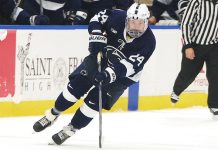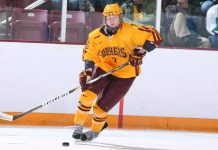Proponents of the United States junior and prep school systems can breathe easier thanks to amendments recently made to the NCAA’s Academics/Eligibility/Compliance Cabinet’s amateurism deregulation proposal.
The original proposal from the sub-committee on Amateurism and Agents, completed last year after a lengthy study, would not only have opened the door for major junior players to enter U.S. colleges — seen by many as a positive, but something currently prohibited — but also hurt U.S. junior-A and prep school leagues by forcing their players to lose one year of NCAA eligibility for each year after the age of 18 played outside of college.
But under the new amendments, agreed upon at the sub-committee’s meeting in Tampa Bay last month, athletes who participate in U.S. junior leagues would have a two-year exception, and prep school athletes would get a one-year exception, effectively continuing the status quo in those areas.
“We have taken care of [hockey’s] concerns; they were legitimate concerns,” said Lisa Dehon, chair of the sub-committee.
“If you look at the purpose of deregulation, one was competitive equity. In most sports, our kids come in out of high school, but because of increasing opportunities, some kids take advantage of things before college.
“Well, in men’s ice hockey, the vast majority come from USA Hockey leagues with one or two years experience after high school. In hockey, that’s the norm. They don’t have a competitive advantage against one another. Therefore, our wanting to maintain competitive equity wasn’t going to be done if [the] proposal were applied to hockey. So we’re keeping them at the status quo.”
Major junior leagues do not get the exception, but the door will be more open for major junior players to join collegiate teams, under terms retained from the original proposal (see below).
The prep school exception will cover all sports.
“That’s closely tied to academics, and we don’t want to negatively impact that,” Dehon said.
“This keeps status quo for majority of U.S. kids, but it also opens up opportunities for U.S. and Canadian kids who perhaps made a mistake [by entering major juniors]. They now have college as an alternative.”
If the new timeline holds up (see sidebar), the current deregulation proposal is scheduled for final approval from the NCAA Management Council and Board of Directors in April, 2001, to take effect for those enrolling in college after August, 2001.
After a two-year study, the sub-committee on Amateurism and Agents forwarded legislation last September that, if passed, completely changes the landscape of NCAA eligibility standards for all sports. Whereas playing in a pro league, taking money and signing endorsement deals were once taboo, the new rules would eliminate all of those issues.
Instead, you would be allowed, after high school graduation, to play anywhere you want, take any money (except to pay for educational expenses), sign any contract, and still have four years’ eligibility remaining, with the stipulation that, for each year you played in a competitive league, you would lose one year of NCAA eligibility.
“It doesn’t matter where you did it or what it’s called, it only matters what you did,” said Dehon.
The effect on hockey would have been enormous. For one, it would open the door to Canadian major junior players to leave and enroll at U.S. colleges, something many have longed for (though there are many detractors among coaches).
The problem for hockey, however, was that “competitive league” meant anything after age 18 that wasn’t college, including U.S. junior-A leagues like the USHL, prep school leagues, and Canadian Tier II, where players routinely compete until they are 19 or 20 before entering college. Those players would have lost a year or two of collegiate eligibility and have to sit out a year.
The hockey community was thrown into a state of confusion over what to do about the situation. Some didn’t want the new deregulation rules at all, some liked them if not for the loss of eligibility for prep school and junior players, and still others didn’t mind any of it.
But the NCAA left the door open for changes to the initial plan, assuming the hockey community could come to a consensus. So, after weeks of discussions between the hockey commissioners, school athletic directors and member coaches, a consensus was reached and the hockey commissioners, led by Tom Anastos (CCHA) and Bruce McLeod (WCHA), presented a formal proposal to the NCAA subcommittee outlining how hockey is different from other sports.
“All the exceptions are fair,” said Dehon. “They all stand up when you consider the core values that the committee has been involved in. Hockey is unique in where they get student-athletes. If we want to be honest about competitive equity, we have to say there may not be an imbalance.
“It shows we’re not just giving lip service to being open. What it does show is you can’t just come and say ‘It’s bad.’ You have to show us data how it affects you sport, how significant the impact is and how it flies in face of what we’re trying to do. If you do, we’ll help you put together a proposal.”
Hockey was the first sport to come to the committee with major concerns. Other sports have had their issues addressed simply through clarification from the committee.
One concern among hockey people is whether the U.S. will lose more players to major juniors than before, because those kids can test the waters and still know they can return to college if things don’t work out. But Dehon doesn’t think that should be a major worry.
“Kids make a decision because they think they can be a pro, not because they don’t want to go to college,” Dehon said. “The thinking process stays the same whether there’s deregulation or not. What I’m sure does happen is, you have many kids who are incorrectly advised and have unrealistic notions of their abilities. Those are the ones we help.”
One sport, however, that may hold things up is men’s basketball.
Many men’s basketball coaches have expressed concern over the can of worms that will be created. Will they have to recruit in the CBA or even the NBA, and how much harder will it be to keep an eye on improper recruiting in that case?
“It opens up Pandora’s box,” said Bill Wilkinson, head hockey coach at Wayne State. “It becomes a free-for-all between majors and pros and college. Will it help kids at 16 making a decision? Probably. It allows them to make that decision more easily. But we won’t know until three years down the road what the real impact is.”
The final proposal will go to the full cabinet in June, so the committee wants basketball to decide on a course of action by then, or it will risk another delay in the timetable.


